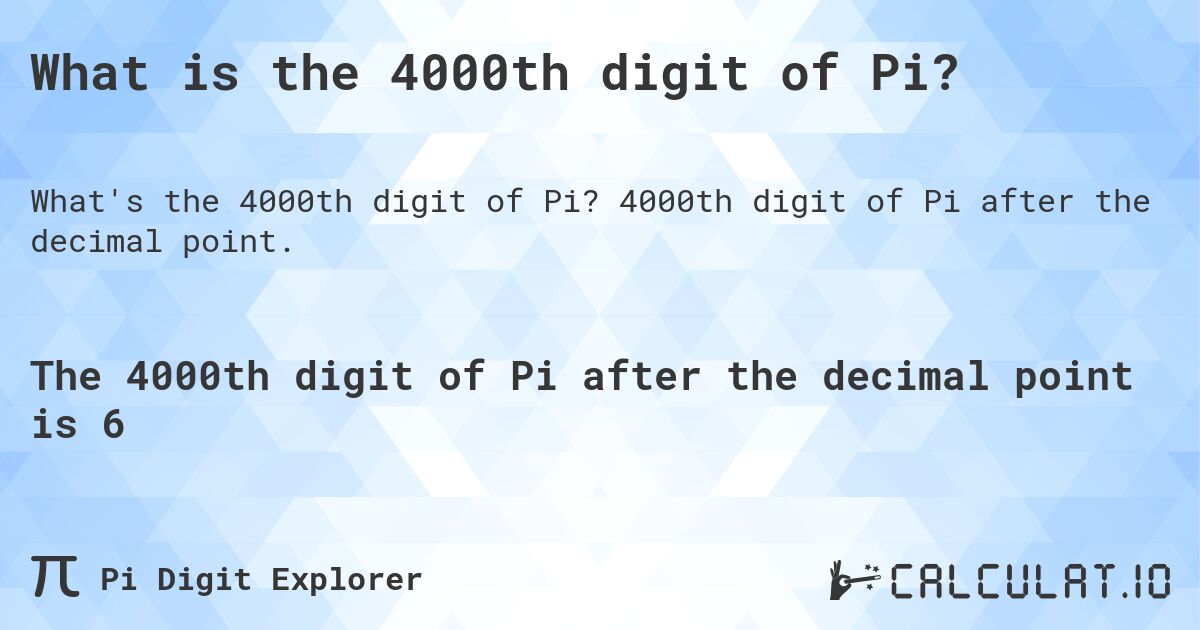4000th digit of Pi
What's the 4000th digit of Pi?
Discover the 4000th digit of Pi
| Position | Digits |
|---|---|
| 3,501-3,600 | 6711136990865851639831501970165151168517143765761835155650884909989859982387345528331635507647918535 |
| 3,601-3,700 | 8932261854896321329330898570642046752590709154814165498594616371802709819943099244889575712828905923 |
| 3,701-3,800 | 2332609729971208443357326548938239119325974636673058360414281388303203824903758985243744170291327656 |
| 3,801-3,900 | 1809377344403070746921120191302033038019762110110044929321516084244485963766983895228684783123552658 |
| 3,901-4,000 | 2131449576857262433441893039686426243410773226978028073189154411010446823252716201052652272111660396 |
| 4,001-4,100 | 6655730925471105578537634668206531098965269186205647693125705863566201855810072936065987648611791045 |
| 4,101-4,200 | 3348850346113657686753249441668039626579787718556084552965412665408530614344431858676975145661406800 |
| 4,201-4,300 | 7002378776591344017127494704205622305389945613140711270004078547332699390814546646458807972708266830 |
| 4,301-4,400 | 6343285878569830523580893306575740679545716377525420211495576158140025012622859413021647155097925923 |
| 4,401-4,500 | 0990796547376125517656751357517829666454779174501129961489030463994713296210734043751895735961458901 |
Interesting facts about Pi
The sequence 6666666666 is the only 10+ digit single-digit number that is contained in the first billion digits of Pi. It appears at 386,980,412 position.
The sequence 999999 occurs in the first 1,000 digits of pi. Chance of this is less than 0.0995% (1 in 1,005)
It's also called Feynman Point: One of the most famous sequences within Pi occurs at the 762nd decimal place, where six consecutive nines appear. This sequence is known as the "Feynman Point" after physicist Richard Feynman, who jokingly claimed that he wanted to memorize the digits of Pi up to this point so he could recite them and end with "nine nine nine nine nine nine and so on," implying that Pi is rational.
March 14th (3/14) is celebrated worldwide as Pi Day because the date resembles the first three digits of Pi (3.14). Pi Day was officially recognized by the U.S. House of Representatives in 2009, and it's celebrated with pie eating, discussions about Pi, and even pi-reciting competitions.
Randomness in Pi: Although the digits of Pi appear random and no pattern has been discerned, Pi is used in random number generation and simulations, further highlighting its utility and intrigue in scientific and mathematical applications.
There are no occurrences of the sequence 123456 in the first 2 millions digits of Pi. It appears only at 2,458,885 position. Although, the probability of encountering any sequence of 6 characters in this segment is quite high.
Pi has a 12345 sequence in the first 50k digits. It appears at 49,702 position
Sequence 123456789 appears 2 times in the first billion digits of Pi.
What is Pi number?
Pi (π) is a fundamental mathematical constant representing the ratio of a circle's circumference to its diameter. This ratio remains constant for all circles, making pi an essential element in various fields of mathematics and science, especially in geometry, trigonometry, and calculus. Pi is an irrational number, meaning it cannot be expressed as a simple fraction, and it is also transcendental, indicating that it is not a root of any non-zero polynomial equation with rational coefficients.
The value of Pi is approximately 3.14159, but its decimal representation goes on infinitely without repeating, showcasing an endless, non-repeating sequence of digits beyond the decimal point. Due to its infinite nature, pi is usually approximated in calculations, with varying degrees of precision depending on the requirements of the specific application, such as 3.14, 22/7, or more precise decimal representations for more accurate calculations in scientific research and engineering projects. The study and computational quest to determine more digits of pi is a continuing effort in the mathematical community, symbolizing both the pursuit of knowledge and the limits of computational precision.
See Also
- Pi Digits Explorer - Pi up to a specified number of digits
- Pi Sequence Finder - Discover Your Numbers in Pi - Phone Numbers, Birthdays etc...
- Download digits of Pi - Download digits of Pi from 1000 to 1 billion

Pi Digits Table
| Digit Position | Digit |
|---|---|
| 3985 | 2 |
| 3986 | 6 |
| 3987 | 5 |
| 3988 | 2 |
| 3989 | 2 |
| 3990 | 7 |
| 3991 | 2 |
| 3992 | 1 |
| 3993 | 1 |
| 3994 | 1 |
| 3995 | 6 |
| 3996 | 6 |
| 3997 | 0 |
| 3998 | 3 |
| 3999 | 9 |
| 4000 | 6 |
| 4001 | 6 |
| 4002 | 6 |
| 4003 | 5 |
| 4004 | 5 |
| 4005 | 7 |
| 4006 | 3 |
| 4007 | 0 |
| 4008 | 9 |
| 4009 | 2 |
| 4010 | 5 |
| 4011 | 4 |
| 4012 | 7 |
| 4013 | 1 |
| 4014 | 1 |
About "Pi Digit Explorer" Calculator
Pi Digit Explorer is an innovative online tool designed for enthusiasts of mathematics, educators, and the curious alike, offering an interactive way to explore the endless digits of pi (π), the mathematical constant that is fundamental to understanding circles. With Pi Digit Explorer, users can embark on a unique journey through the infinite sequence of pi's digits, which have fascinated mathematicians and enthusiasts for centuries.
For example, it can help you find out what's the 4000th digit of Pi? (The answer is: 6).
Users can enter any position (e.g., the 4000th digit) to instantly identify the corresponding digit of pi after the decimal point, within the confines of the first 100 million digits.
Whether you're a math teacher looking to inspire your students, a student working on a project about pi, or simply someone fascinated by the mysteries of mathematics, Pi Digit Explorer offers a portal to delve into the digits of pi like never before. Explore the digit that lies in the 69th position, delve into the depths of the first 10,000 digits, or set your sights on any number up to the 100 millionth digit. Every search is a step into the vast numerical universe of pi, limited only by your curiosity and the 100 million digit boundary.